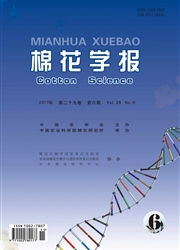

 中文摘要:
中文摘要:
为了揭示新疆棉花栽培技术中"打顶"措施与棉花早衰问题之间的关系,在水培条件下研究了低氮(1.0×10-3mol.L-1)和高氮(4.0×10-3mol.L-1)两种供氮水平下,不打顶、打顶、打顶后涂抹羊毛脂和打顶后涂抹羊毛脂+萘乙酸处理对棉花功能叶丙二醛含量和根系活力的影响。结果表明:在两种供氮水平下,棉花打顶、打顶后涂抹羊毛脂和涂抹羊毛脂+萘乙酸处理比不打顶处理根系活力增幅分别为94.4%~110.0%、55.9%~85.7%和51.5%~147.4%,差异显著;丙二醛(MDA)含量增幅分别为12.0%~17.3%、5.2%~6.5%和9.7%~10.9%,差异不显著。打顶和打顶后涂抹萘乙酸可促进棉花根系生长,提高根系活力和总吸收面积。
 英文摘要:
英文摘要:
A hydroponics experiment was conducted to investigate the effects of decapitation which is a conventional technique in cotton production in Xinjiang on the root activity and malonaldehyde (MDA) content of cotton under low and high nitrogen supply, respectively. The results showed that comparing with non-decapitated plants, the root activities of the decapitation, the decapitation plus smearing lanolin, the decapitation plus smearing lanolin and NAA treatments were remarkablely increased by 94.4% - 110.0%, 55.9% -85.7% and 51.5% - 147.4%, respectively; and the MDA content were also increased by 12.0% 17.3%, 5.2%-6.5% and 9.7%- 10.9%, respectively. It is concluded that the decapitation and decapitation plus NAA smearing enhanced the growth of plant, and the activity and the total absorbing area of cotton roots.
 同期刊论文项目
同期刊论文项目
 同项目期刊论文
同项目期刊论文
 期刊信息
期刊信息
